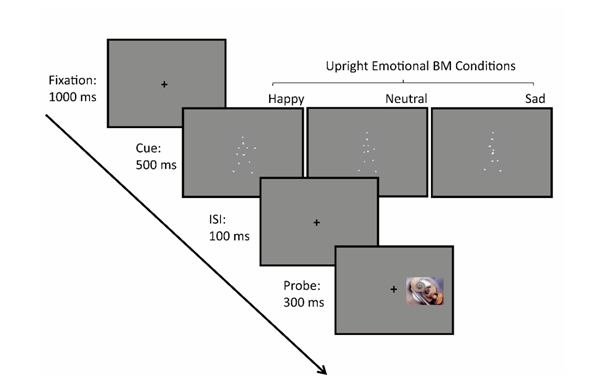When we spot others looking in a particular direction, we tend to redirect our attention towards their attentional focus. This ability to readily detect interactive partners’ focus of attention, known as social attention, is crucial for interpersonal interactions and adaptive social behaviors. In addition to directional signals, social cues also convey important information regarding others' emotional states. When both emotional and directional information are present, social cues could not only reveal others' attentional focus but also relay affective evaluation regarding the nature (good or bad) of the event/object he or she is attending to. The combined information should modulate social attention effect so as to facilitate the detection of potential rewards or punishments in the environment. However, the existing evidence remains controversial regarding whether emotions can modulate social attention.
To probe this issue, a group of researchers from the Institute of Psychology of the Chinese Academy of Sciences (CAS), led by Dr. Yi Jiang, employed two distinct types of emotional social cues, namely biological motion (BM) and face, in a classic modified central cueing paradigm. Previous studies have shown that despite the substantial differences in low-level visual features between BM and face, the perception and emotion processing of BM and face involve very similar mechanisms. Moreover, both types of social cues elicit significant social attention effects, which are supported by common neural mechanisms (Wang et al., 2020) and genetic basis (Ji et al., 2020). These observations inspire researchers to investigate and compare the emotional modulations on social attention triggered by these two types of cues.
In Experiment 1, researchers presented a happy, sad, or neutral point-light BM walking leftwards or rightwards at the center of the screen. Subsequently, a target picture appeared on either the left or right side of the screen, and participants were required to press a key to indicate the location of the target as quickly and accurately as possible (Figure 1). Besides, to control for low-level confounds, Experiment 2 presented the inverted walkers that shared identical low-level visual features with the upright ones.

Figure 1. Schematic representation of the experimental procedure of the BM cueing task in Experiment 1.Image by YUAN Tian.
To further investigate the modulation effect of facial expressions on social attention, Experiment 3 presented happy, sad, and neutral faces with averted eye gaze as the central cues (Figure 2). Similarly, in Experiment 4, researchers presented inverted faces to control for low-level differences.

Figure 2. Schematic representation of the experimental procedure of the Gaze cueing task in Experiment 3. Image by YUAN Tian.
Our results demonstrated that happy BM elicited a stronger attention orienting than that induced by neutral and sad BM (Figure 3A). However, this modulation disappeared when the central BM cues were presented upside-down (Figure 3B). Importantly, even though face and BM differed significantly in in visual features, similar emotional modulation effects are observed: happy faces elicited a stronger attention effect as compared to neutral and sad faces (Figure 3C). Furthermore, when faces were presented upside-down, the emotional modulation similarly disappeared (Figure 3D).

Figure 3. Mean magnitude of the standardized cueing effects plotted against emotional conditions for the four experiments (each point represents one individual data). * p < .05. Image by YUAN Tian.
Pointing direction and emotion, as two fundamental attributes of social signals, convey important information regarding others' intentions and internal states. This study demonstrates that the happy but not sad emotion could interact with pointing directions to modulate social attention. More importantly, this "happiness advantage" is observed in attentional effects induced by both BM and face. These findings together reveal a shared emotional modulation on social attention triggered by different types of social signals, and further suggests the existence of a general “social attention detector” closely interconnected with emotional processing.
This study has been published in Emotion. This work was supported by the Ministry of Science and Technology of China, the National Natural Science Foundation of China, the Strategic Priority Research Program, the Key Research Program of Frontier Sciences, and the Fundamental Research Funds for the Central Universities.
More information:
Yuan, T., Ji, H., Wang, L., & Jiang, Y. (2023). Happy is stronger than sad: Emotional information modulates social attention. Emotion, 23(4), 1061–1074.
References:
Ji, H., Wang, L., & Jiang, Y. (2020). Cross-category adaptation of reflexive social attention. Journal of Experimental Psychology: General, 149(11), 2145-2153. https://doi.org/10.1037/xge0000766
Wang, L., Wang, Y., Xu, Q., Liu, D., Ji, H., Yu, Y., Hu, Z., Yuan, P., & Jiang, Y. (2020). Heritability of reflexive social attention triggered by eye gaze and walking direction: common and unique genetic underpinnings. Psychological Medicine, 50(3), 475-483. https://doi.org/10.1017/S003329171900031X
LIU Chen
Institute of Psychology Chinese Academy of Sciences
Beijing 100101, China.
E-mail: liuc@psych.ac.cn
